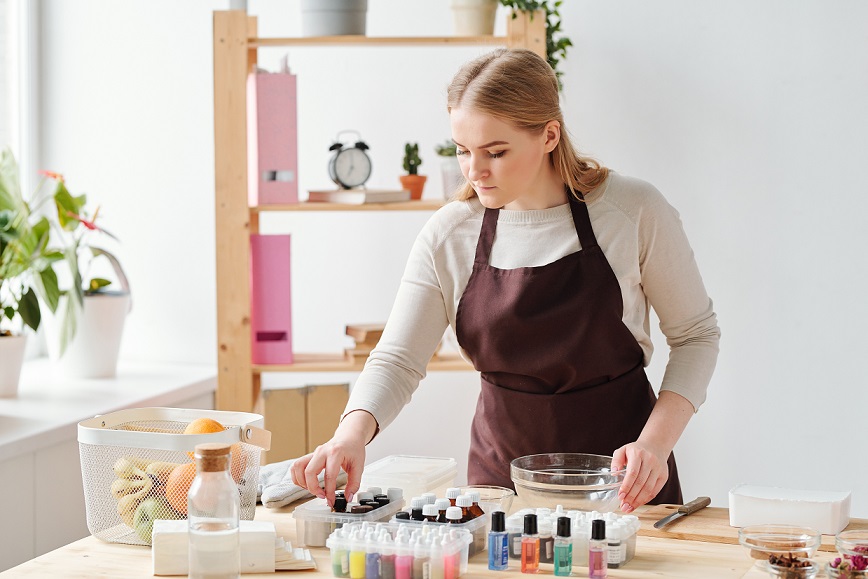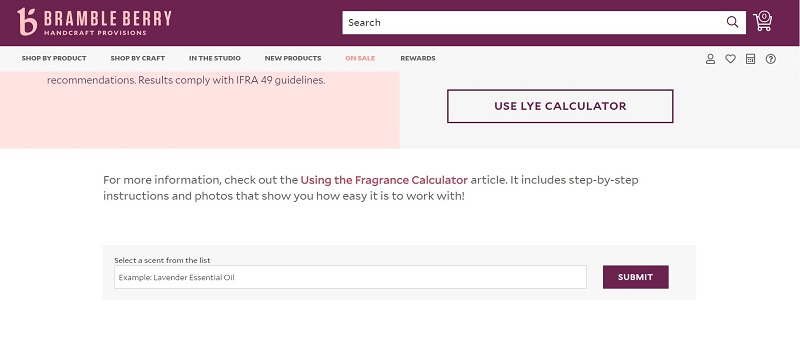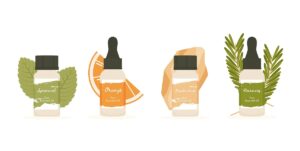Blending Essential Oils:
Cold process soap making is fun for so many reasons. There is something special about coming up with your own cold process soap recipe. Alternately, recalculating an already working recipe into your own, coming out with a beautifully crafted homemade soap. There is also something special about blending-up your own aromas. In the case of today’s post, blending essential oils.

When you first begin your journey as a soaper, getting past the early phases of understanding the lingo, understanding the science and starting to formulate your very first recipe, is hard enough, right! However, once you have a strong understanding of the basics, the next thing that you can do is play around with scent profiles and blending or mixing fragrances and essential oils. It may just be one of the most exciting parts of soaping (at least it is for us here at RN to Zen).
Blending fragrances and/or essential oils can be something that sets you apart from other soap makers and makes your company unique. That said, there are important things to know and learn about how to safely and effectively blend oils.
Why Essential Oils?
Chances are, you’ve heard about essential oils before. Oftentimes, you’ll here about them in regards to aromatherapy, aromatherapy massages, their usage in aromatherapy diffusers, and other bath and beauty products. However, they are even a popular choice in soap making, for scenting purposes.
Essential oils are plant extracts, where parts of a plant (flower, leaves etc.) are steamed distilled or pressed to capture their compounds which produce an aroma. High quality essential oils are not cheap! This is because when done right, it can take pounds of plants to achieve enough extraction of oils to produce one bottle.
According to The National Institute of Environmental Health Services, it takes approx. 220lbs of lavender flowers to produce 1 pound of lavender essential oil. Wow!
These extracts retain there natural smell and flavor of whatever their source is. The compounds within the flowers, bark, even leaves extracted, have been touted or studied to have certain medicinal usages. For example, headache relief, anxiety relief, antioxidative properties, even antimicrobial properties.
However it’s important to note there is not enough research to verify many of the claims in human health, according to Johns Hopkins Medicine.
Still, many people swear by using essential oils as natural health remedies. Nonetheless, essential oils are all natural, and smell amazing in homemade soap. As such, many soapers choose to include them in recipes because of these properties.
Here is a list of popular essential oils and notes about each.

More popular essential oils used in cold process soap making that tend to hold there scent well are lavender, peppermint, and lemongrass. Essential oils like lemon, orange and lime are best paired with complementary oils. This is also known as anchoring with deeper, richer, more long lasting scents that help retain more subtle oils.
Using Essential Oils in Bath and Body Products!
Likewise to fragrance oils, not all essential oils are created equal. Hence, the importance of purchasing from reputable companies. Each and every essential oil also has it’s own usage rate depending on what you’re making (i.e. soaps, bath bombs, lotions, shampoos, candles). Oftentimes, this is based on extensive testing by the supplier.
Wait….What? Based on suppliers tests?
That’s right! You see “fragrance” oils are based off of usage rates recommended by the IFRA. The IFRA or International Fragrance Association for four decades has set boundaries for fragrance creations. It’s kind of like a governing body for fragrances, making sure consumers are enjoying fragrances with confidence, setting criteria for certain ingredients.
However, for essential oils there are no “official” recommended usage rates from this body (IFRA).
Luckily many suppliers now have built in fragrance calculators in which you can enter the amount of soap, bath bomb mixture or lotion needed, and it will return with the amount of oils to use for light, medium, or heavy scents.
These suppliers have most likely spent quite a bit of time and money testing these essential oils for their own recommendations.
Related Article: Process of Blending & Mixing Essential Oils to Perfection, Part II: Top, Middle & Base Notes!
Blending Essential Oils: Tips & Tricks!
Blending essential oils, although not rocket science, can be a bit tricky!
How do you do it, is the question.
It helps to know common essential oils (and there properties) that cause issues in soap making or even ones that may commonly irritate skin.
You will be less likely to run across essential oils that irritate the skin in soaps, because the soap is washed off the skin quickly!
Some essential oils just don’t play well in CP soap making! For example, clove essential oils (more so then others) is prone to causing a batter to seize. Other essential oils, specifically, citrusy scents, tend to have trouble sticking in cold process soap. Meaning there fragrance either doesn’t last saponification (due to pH and heat), or it makes it through, but at a much lesser degree. These scents even tend to fade quickly over time or to be non-existent after the soaps cure.
One Method For Blending Essential Oils:
Step 1: Choose the essential oils you wish to blend & your batter amount.
CP Soap Batter: 44 oz.
Essential Oils:
- Levander essential oil
- Bergamot essential oil
- Rosemary essential oil
Step 2: Input these into your suppliers fragrance calculator one at a time.
Remember, these are NOT IFRA values, they are supplier recommendations.
CP Soap Batter: 44 oz.
For Example: BrambleBerry.com Fragrance Calculator!

We entered Lavender essential oil (shown above) into the search bar and hit the “next” button.

What are we making: CP soap
How Much: 44oz.
Measurement: Oucnes
Then, hit “next”.
The example we used is lavender. You would initially do this for each essential oil (bergamot and rosemary) to find it’s MAX usage rate to safely use this oil.
The results of all 3 are below…
- Levander essential oil: For strong scent; 2.64 ounces
- Bergamot essential oil: For strong scent; 2.20 ounces
- Rosemary essential oil: For strong scent; 2.20 ounces
Step 3: Determining What This Means
#1: The max usage rate (for strong scent) for Bergamot & Rosemary essential oils are the same: 2.20 ounces.
#2: Meaning, the max amount of either one of these oils I can use in my soap is 2.2 ounces! The max amount of “total” oils I can use in the soap is 2.64!
#3: The maximum usage rate for Lavender is slightly higher at 2.64 ounces. Because this is my higher end oil amount, this is the maximum I can use (in ounces) of the 3 oils combined.
Step 4: How Much of Each?
Trickiest part!
Firstly, it’s helpful to have an idea of how well these oils hold up in CP soap. Secondly, how they smell together. Thirdly, whether one will over-power the other.
This is a personal preference thing. However, we know from experience these smell great together!
We like TOP notes of lavender, MIDDLE of bergamot, and BOTTOM of rosemary.
So for this soap, we’ll do:
- Lavender: 1.5 ounces
- Bergamot: 0.8 ounces
- Rosemary: 0.34 ounces
= 2.64 Total
In our opinion, this will yield the strongest scent profile for this amount of soap at 2.64 ounces of essential oils combined.
However, let’s say you want to adjust slightly. You want 1.6 ounces of lavender.
This will now put it over the 2.64 ounces, if you keep the bergamot and rosemary the same. So, you’ll have to either decrease one of them, or both slightly.
You don’t have to use the max of 2.64 ounces. Adjust it for a lighter scent, if you wish.
Bonus Tips For Making Essential Oils Last In CP Soaps!

1. Substitute common citrus scents that have trouble making it through the environment of cold process soap making.
Examples:
- Lemongrass, for lemon essential oil,
- 10x orange, for orange essential oil.
2. Try anchoring your essential oils with kaolin clay. Oils can adhere to the clay for added staying power!
3. Store away from direct heat or sunlight. Cool dry environments work the best. Dip cotton swab in the oil, and place close to the soap when curing.
4. Check your usage rates. If your usage rate was lighter then you would like and you have room to increase, then do it!
5. Pay attention to temperature. Fragrance oils have a flashpoint. If using essential oils with lower flashpoint, try to soap at lower a temperature.
6. Typically you’ll want your blends to have a “top, middle and base” note or notes. Some essential oils like lavender can act as both a top note and a middle note. For the betterment of this blog, we will keep this a basic tip, but you can explore this in more detail on your leisure.
7. Test. Test. More Testing!
Final Thoughts!
There is no way around it, the more you practice and test recipes the better you’ll get. If one essential oil did not stick as much as you would like, don’t right away give up on it so quickly. Maybe there is something you did or could do different to help anchor it better or maybe you just need to increase the amount to your recipe!
If there are other techniques you use we would love to hear them and so would the community of soapers.
Thanks for coming by and happy soaping!!!
References:
- https://www.hopkinsmedicine.org/health/wellness-and-prevention/aromatherapy-do-essential-oils-really-work
- https://www.niehs.nih.gov/health/topics/agents/essential-oils/index.cfm


